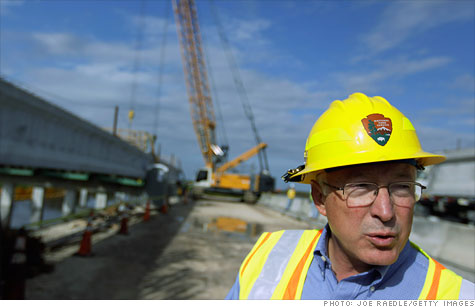Search News

Interior secretary Ken Salazar visits the Tamiami Trail Bridge Project that is being built to restore fresh water flows to Everglades National Park and the south Florida ecosystem.
NEW YORK (CNNMoney) -- The tactic du jour for environmentalists trying to sell a skeptical public on tighter regulations is this: spin the thing as a job creator.
Last week a Maryland-based environmental group said efforts to clean up the Chesapeake Bay would actually create 240,000 jobs over the next several years, mainly by employing people to upgrade sewage systems.
In a recent report defending stricter mercury pollution limits on power plants, the Environmental Protection Agency said 8,000 more people would be needed to build and run the pollution control equipment than would be laid off as a result of older plants shutting down.
Economists that aren't aligned with either industry or activist groups say that, when it comes to creating or destroying jobs, environmental regulations come out somewhere near neutral -- adding costs to industry but producing benefits in public health or other areas.
But they say framing the argument just in terms of jobs is misleading, at least in times of economic expansion. This applies not only to environmental groups but also industry, like recent claims that the controversial Keystone pipeline expansion will create 20,000 jobs.
"That's monkey math," Trevor Houser, a visiting fellow at the Peterson Institute for International Economics. "They assume that if the money isn't spent on that project, it will get burned in the street."
If the new sewage systems aren't built in towns neighboring the Chesapeake, the local governments would likely spend it on something else, creating just as many jobs. If they instead returned it to tax or ratepayers, those people would likely spend it on something else.
Same is true with the pipeline. If Keystone can't be built then another project would likely go forward. If no other projects are in the works, the company might book the cash as profits and return it to shareholders in the form of dividends, which could then be spent on Bentleys or burgers or whatever it is that shareholders buy.
The one exception to this, said Houser, is in times of recession or extremely slow economic activity. Then companies may just sit on the cash, like they are now.
There is one important difference between, say, a new pipeline and a project that seeks to clean the air or water.
The pipeline would create a new service -- in Keystone's case an extra 700,000 barrels of oil a day brought to the Gulf Coast.
The bay project or the air pollution rules don't offer anything new. No more sewage is being disposed of. No more electricity is being made. An existing service is simply being made pricier.
"Environmental regulations do make the cost of doing business more expensive," said Chris Lafakis, an economist at Moody's Analytics specializing in energy issues. "If you want to make the air quality better or water quality better, that is not free."
Despite EPA's prediction that its new mercury rules will have a net effect of creating 8,000 more jobs, Lafakis said it's rare that additional regulations will result in more jobs than will be lost in regulating the industry.
But that's not where the calculations should end, he said. Cleaner air and water do benefit the economy.
Fewer people get sick, lessening the burden on the nation's health care system. Fewer people stay home from work. Cleaner water can often mean new jobs in other industries, like fishing. And the search itself for cleaner technologies can often translate into new products being discovered or processes invented that improve productivity in other sectors of the economy.
"There are tangible benefits to removing [pollution] from the environment, and they should not be minimized" said Lafakis.
Jim Glassman, a senior economist at J.P. Morgan, agreed.
"Imposing regulations doesn't lead to jobs, but jobs aren't why we do it," said Glassman. "There are benefits -- cleaner air, better health."
In fact, the EPA is required to do a cost benefit analysis that encompasses just such things before every new rule it proposed.
In the recent mercury ruling, EPA said it would cost just under $10 billion for power plants to install the necessary equipment but yield $30 to $90 billion in health benefits each year. That's not even counting the 11,000 lives each year EPA says the new rules will save.
Lafakis said there's constant bickering between environmentalists, regulators and industry about just what numbers EPA uses in its analysis, with environmentalists constantly saying the health benefit estimates are too low and industry arguing that their estimates for the compliance costs are also too low.
In general though, he said EPA's current studies are usually pretty accurate. Historically, he said both industry and the government have usually overestimated how much it costs to clean the environment. ![]()
| Overnight Avg Rate | Latest | Change | Last Week |
|---|---|---|---|
| 30 yr fixed | 3.80% | 3.88% | |
| 15 yr fixed | 3.20% | 3.23% | |
| 5/1 ARM | 3.84% | 3.88% | |
| 30 yr refi | 3.82% | 3.93% | |
| 15 yr refi | 3.20% | 3.23% |
Today's featured rates:
| Latest Report | Next Update |
|---|---|
| Home prices | Aug 28 |
| Consumer confidence | Aug 28 |
| GDP | Aug 29 |
| Manufacturing (ISM) | Sept 4 |
| Jobs | Sept 7 |
| Inflation (CPI) | Sept 14 |
| Retail sales | Sept 14 |